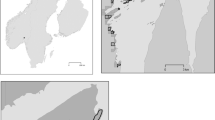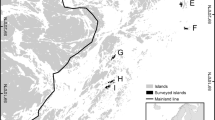Abstract
Assessing and predicting the species richness of a complex landscape remains a problem because there is no simple scaling function of species richness in a heterogeneous environment. Furthermore, the potential value of an area for biodiversity conservation may depend on which, rather than how many, species the area contains. This paper shows how we can objectively evaluate the contribution of an area, e.g., a habitat patch, to larger-scale plant species richness, e.g., a landscape composed of patches of several habitat types, and how we can test hypotheses that attempt to explain this contribution. We quantified the concept of habitat specificity to assess the proportion of each observed plant population that is concentrated within a given spatial element. A case study of a biodiversity-monitoring program in the Swiss Canton of Aargau showed that the relative contribution of the three main types of land use to the overall species richness differed strongly between higher taxa (vascular plants and molluscs). However, the type of data, i.e., presence-absence or abundance, was not important. Resampling of the plant data suggested that stratification provided an unbiased estimate of relative specificity, whereas unstratified sampling caused bias even for large samples. In a second case study of vascular plants in an agricultural landscape in central Switzerland, we tested whether the type, size or shape of a landscape element can predict its contribution to the species richness of the landscape. Habitat types that were less frequently disturbed contributed more per m2 to landscape species richness than more frequently disturbed ones. Contrary to expectation, patch size was negatively correlated to specificity per m2 for arable fields, whereas patch shape appeared to be unrelated to the specificity per m2 both for arable fields and for meadows. The specificity approach provides a solution to the problem of scaling species richness and is ideally suited for testing hypotheses on the effect of landscape structure on landscape species richness. Specificity scores can easily be combined with measures of other aspects of rarity to assess the contribution of a spatial element to conservation goals formulated at regional, national or global level.
Similar content being viewed by others
References
Bunge, J. and Fitzpatrick, M. 1993. Estimating the Number of Species: A Review. J Am Stat Assoc 88: 364–373.
Colwell, R. K. and Coddington, J. A. 1994. Estimating terrestrial biodiversity through extrapolation. Phil Trans Roy Soc London B Biol Sci 345: 101–118.
Davis, J. C. 1986. Statistics and Data Analysis in Geology Wiley. New York, NY, USA.
Duelli, P. 1992. Mosaikkonzept und Inseltheorie in der Kulturlandschaft. Verh Ges Oekologie (Berlin 1991) 21: 379–384.
Duelli, P. 1997. Biodiversity evaluation in agricultural landscapes. An approach at two different scales. Agric Ecosys Environ 62: 81–91.
Dufrene, M. and Legendre, P. 1997. Species assemblages and indicator species: The need for a flexible asymmetrical approach. Ecol Monog 67: 345–366.
Forman, R. T. T. 1995. Land mosaics: the ecology of landscapes and regions. Cambridge University Press, Cambridge, UK.
Forman, R. T. T. and Godron, M. (1986). Landscape Ecology Wiley. New York, NY, USA.
Gaston, K. J. 1994. Rarity. Chapman and Hall, London.
Gaston, K. J. 1996a. Species richness: measure and measurement. In Biodiversity: A Biology of Numbers and Difference. pp. 77–113. Edited by K. J. Gaston. Blackwell Science, Oxford, UK.
Gaston, K. J. 1996b. What is biodiversity? In Biodiversity: A Biology of Numbers and Difference. pp. 1–9. Edited by K. J. Gaston. Blackwell Science, Oxford, UK.
Griffith, D. A. 1982. Geometry and spatial interaction. Ann Assoc Am Geographers 72: 332–346.
MacArthur, R. H. and Wilson, E. O. 1976. The Theory of Island Biogeography Princeton University Press, Princeton, NJ, USA.
Palmer, M. W. 1995. How should one count species? Nat Areas J 15: 124–135.
Palmer, M. W. and White, P. S. 1994. Scale dependence and the species-area relationship. Am Nat 144: 717–740.
Rabinowitz, D. 1981. Seven forms of rarity. pp. 205–217. In The biological aspects of rare plant conservation. H. Synge. Wiley: Chichester, UK.
Ricketts, T. H., Dinerstein, E., Olson, D. M., and Loucks, C. 1999. Who's where in North America? Bioscience 49: 369–381.
Stohlgren, T. J., Coughenour, M. B., Chong, G. W., Binkley, D., Kalkhan, M. A., Schell, L. D., Buckley, D. J. and Berry, J. K. 1997a. Landscape analysis of plant diversity. Landsc Ecol 12: 155–170.
Stohlgren, T. J., Chong, G. W., Kalkhan, M. A. and Schell, L. D. 1997b. Rapid assessment of plant diversity patterns: A methodology for landscapes. Environ Monit Assessment 48: 25–43.
Suter, W., Bürgi, M., Ewald, K. C., Baur, B., Duelli, P., Edwards, P. J., Lachavanne, J. B., Nievergelt, B., Schmid, B. and Wildi, O. 1998. Die Biodiversitätsstrategie als Naturschutzkonzept auf nationaler Ebene. GAIA 7: 174–183.
Wagner, H. H., Ewald, K. C. and Wildi, O. 2000. Additive partitioning of plant species diversity in an agricultural mosaic landscape. Landsc Ecol. 15: 219–227.
Wagner, H. H. and Wildi, O. submitted. Spatial heterogeneity and abundance distribution affect non-parametric estimators of species richness. Environmental and Ecological Statistics.
Williams, P. H. 1999. Key sites for conservation: area-selection methods for biodiversity. In Conservation in a Changing World. Edited by G. M. Mace, A. Balmford and J. R. Ginsberg. pp. 221–249. Cambridge University Press, Cambridge, UK.
Author information
Authors and Affiliations
Rights and permissions
About this article
Cite this article
Wagner, H.H., Edwards, P.J. Quantifying habitat specificity to assess the contribution of a patch to species richness at a landscape scale. Landscape Ecology 16, 121–131 (2001). https://doi.org/10.1023/A:1011118007670
Issue Date:
DOI: https://doi.org/10.1023/A:1011118007670




